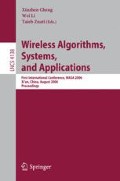Abstract
In this paper, we propose a power efficient MAC protocol (PEMP) for IEEE 802.11 multihop ad hoc networks. Most of related work targeted at single hop ad hoc networks. In PEMP, when a node intends to transmit data, it will piggyback a data profile, which includes data size, on ATIM* and ATIM-ACK*. ATIM* and ATIM-ACK* are ATIM and ATIM-ACK with piggybacked data profiles, respectively. In this way, senders and receivers can inform their neighbor nodes of their data profiles. Then, each node calculates its transmission priority according to the collected data profiles. Based on transmission priorities, PEMP can schedule a better transmission sequence to reduce power consumption. By decreasing the idle time in the active state and adjusting the ATIM window dynamically based on network conditions, the power consumption of PEMP is 20% and 10% ~ 30% less than that of DPSM and IEEE 802.11 PSM, respectively. PEMP is applicable to multihop ad hoc networks and can achieve a good tradeoff between power consumption, throughput and delay.
Access this chapter
Tax calculation will be finalised at checkout
Purchases are for personal use only
Preview
Unable to display preview. Download preview PDF.
References
IEEE Std 802.11b, IEEE Standard for Wireless LAN Medium Access Control (MAC) and Physical Layer Specifications: Higher-Speed Physical Extension in the 2.4 GHz Band (1999)
IEEE Std 802.11a, IEEE Standard for Wireless LAN Medium Access Control (MAC) and Physical Layer Specifications: Higher-Speed Physical Extension in the 5 GHz Band (1999)
Zheng, R., Kravets, R.: On-demand power management for ad hoc networks. In: Proc. IEEE INFOCOM, April 2003, vol. 1, pp. 481–491 (2003)
Jung, E.S., Vaidya, N.H.: An energy efficient MAC protocol for wireless LANs. In: Proc. IEEE INFOCOM, June 2002, vol. 3, pp. 1756–1764 (2002)
Ye, W., Heidemann, J., Estrin, D.: An energy efficient MAC protocol for wireless sensor network. USC/Information Sciences Institute
Tseng, Y.-C., Hsu, C.-S., Hsieh, T.-Y.: Power-saving protocols for IEEE 802.11-based multi-hop ad hoc networks. In: Proc. IEEE INFOCOM, June 2002, pp. 200–209 (2002)
Liu, M., Liu, M.T.: A power-saving scheduling for IEEE 802.11 mobile ad hoc networks. In: Proc. ICCNMC, October 2003, pp. 238–245 (2003)
Wu, S.-L., Tseng, P.-C.: An energy efficient MAC protocol for IEEE 802.11 WLANs. In: Proc. IEEE CNSR, May 2004, pp. 137–145 (2004)
Tavli, B., Heinzelman, W.B.: TRACE: time reservation using adaptive control for energy efficiency. IEEE Journal on Selected Areas in Communications, 1506–1515 (December 2003)
IEEE 802.11 WG, IEEE Standard for Information Technology – Telecommunications and Information Exchange between Systems – LAN/MAN Specific Requirements - Part 11: Wireless Medium Access Control (MAC) and Physical Layer (PHY) Specifications: Medium Access Control (MAC) Enhancements for Quality of Service (QoS), IEEE Std. 802.11e (2005)
VINT Group, UCB/LBNL/VINT Network Simulator ns (version 2). [Online] Available: http://www.isi.edu/nsnam/ns
The CMU Monarch Project., The CMU monarch project’s wireless and mobility extension to Ns, [Online] Available: http://www.monarch.cs.cmu.edu/cmu-ns.html
Jung, E.S., Vaidya, N.H.: A power saving MAC protocol for wireless networks, Tech. Rep., July 2002, [Online] Available: http://www.crhc.uiuc.edu/~nhv/papers/npsm_tech.pdf
Johnson, D.B., Maltz, D.A.: Dynamic source routing in ad hoc wireless networks draft-ietf-manet-dsr-04.txt (2001)
Feeney, L.M.: An energy consumption model for performance analysis of routing protocol for mobile ad hoc networks. ACM/Kluwer Mobile Networks and Applications 6(3), 239–249 (2001)
Author information
Authors and Affiliations
Editor information
Editors and Affiliations
Rights and permissions
Copyright information
© 2006 Springer-Verlag Berlin Heidelberg
About this paper
Cite this paper
Wu, HJ., Wang, K., Lee, LS. (2006). A Power Efficient MAC Protocol for IEEE 802.11 Multihop Ad Hoc Networks. In: Cheng, X., Li, W., Znati, T. (eds) Wireless Algorithms, Systems, and Applications. WASA 2006. Lecture Notes in Computer Science, vol 4138. Springer, Berlin, Heidelberg. https://doi.org/10.1007/11814856_30
Download citation
DOI: https://doi.org/10.1007/11814856_30
Publisher Name: Springer, Berlin, Heidelberg
Print ISBN: 978-3-540-37189-2
Online ISBN: 978-3-540-37190-8
eBook Packages: Computer ScienceComputer Science (R0)

